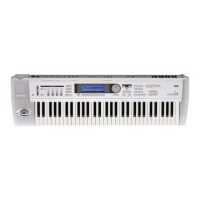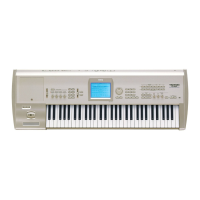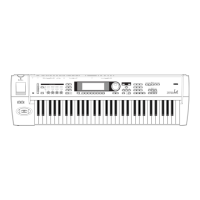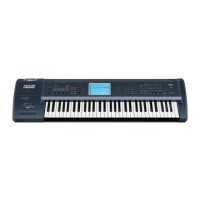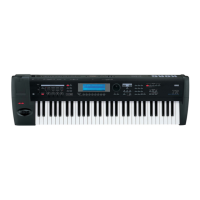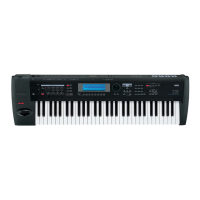10. MIDI applications
63
STEP 3
Aftertouch
If you play a note on the TRINITY and then press down harder on the keyboard, an aftertouch
effect will be applied. At the same time, MIDI Aftertouch messages [Dn, vv] (‘vv’ = value) will also
be transmitted.
If the TRINITY receives these messages, the aftertouch effect will be applied.
In the Global mode MIDI Filter, overall transmission and reception can be turned on or off. In a
combination, you can specify this individually for each timbre.
There is another type of aftertouch, Polyphonic Key Pressure [An, kk, vv] (‘kk’ = note number, ‘vv’
= value), which applies an effect independently for each note. This message can be received by the
TRINITY as an alternate modulation source, but cannot be transmitted by the keyboard of the
TRINITY. If you wish to use these messages, you will have to use another device to transmit them
or record them on a sequencer. The aftertouch referred to in this manual is Channel Aftertouch.
Using pitch bend
When you move the TRINITY’s joystick in the X direction (to the left or right), pitch bend will be
applied. At the same time, MIDI Pitch Bend messages [En, bb, mm] (‘bb’ = lower byte of the value,
’mm’ = upper byte of the value; a total of 16384 levels, with center value at 8192 [‘bb’ and ’mm’ =
00H, 40H]) will be transmitted.
If the TRINITY receives these messages, pitch bend will be applied. The range (depth) of the
resulting pitch bend can also be set via MIDI (see “Changing the pitch bend range”).
Adjusting the volume
When the function of the assignable pedal is set to “volume” and an expression pedal connected
to the assignable pedal jack is operated, the volume of the TRINITY will be adjusted. At the same
time, MIDI Volume messages [Bn, 07, vv] (control change #07: ‘vv’ = value) will be transmitted.
If the TRINITY receives these messages, the volume will be adjusted. The volume of the TRINITY
is determined by the product of the value of the Volume message and the value of the Expression
message [Bn, 0B, vv] (control change #11: ‘vv’ = value). This means that if the volume does not
increase sufficiently in response to Volume messages, or if there is no sound, transmit a MIDI
Expression message to the TRINITY to reset the Expression value to 127.
● When you select a combination, Volume messages will be transmitted from each timbre whose
Timbre Mode is EXT.
● When you select a song, or press the [RESET] key, Volume messages will be transmitted from
each track whose Track Status is EXT or BOTH.
At this time, the internal volume value will be set to the starting value, and the expression
value will be reset to the maximum value.
● The volume of each track of a sequencer song can be controlled independently. Use Volume
messages to set the initial volume (i.e., as part of the starting settings), and use Expression mes-
sages to create changes in volume that are part of the musical data (i.e., as the song progresses).
If you use Event Editing etc. to insert Volume messages into the middle of a track (Volume mes-
sages are normally not used within the body of the song), the subsequent portion of that track
may not playback at the intended volume.
By using the Universal Exclusive message Master Volume (refer to “About system exclusive mes-
sages”), you can adjust the overall volume without changing the balance between timbres or
tracks.
Applying vibrato (oscillator LFO)
When you move the joystick of the TRINITY in the +Y direction (away from you), vibrato will be
applied. At the same time, MIDI Modulation 1 Depth messages [Bn, 01, vv] (control change #01:
‘vv’ = value) will be transmitted.
If the TRINITY receives these messages, vibrato will be applied.
Applying wah-wah (filter LFO)
When you move the joystick of the TRINITY in the –Y direction (toward you), wah-wah will be
applied. At the same time, MIDI Modulation 2 Depth messages [Bn, 02, vv] (control change #02:
‘vv’ = value) will be transmitted.
If the TRINITY receives these messages, wah-wah will be applied. However the way in which this
message is used will differ between manufacturers (e.g., used for Breath Controller, etc.).

